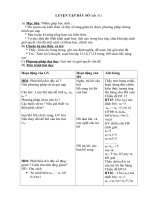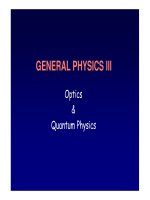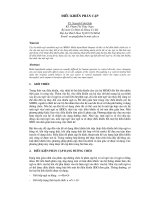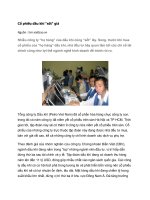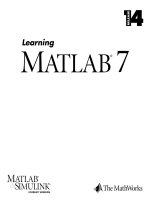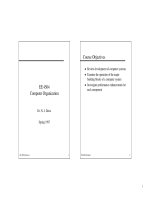Tài liệu Chemical Micro Process Engineering pptx
Bạn đang xem bản rút gọn của tài liệu. Xem và tải ngay bản đầy đủ của tài liệu tại đây (17.25 MB, 684 trang )
Chemical Micro Process Engineering
Processing and Plants
Volker Hessel, Holger Löwe, Andreas Müller, Gunther Kolb
1264vch00.pmd 25.01.2005, 15:253
1264vch00.pmd 25.01.2005, 15:2622
V. Hessel, H. Löwe,
A. Müller, G. Kolb
Chemical Micro Process
Engineering
1264vch00.pmd 25.01.2005, 15:251
Hessel, V., Hardt, S., Löwe, H.
Chemical Micro Process
Engineering
Fundamentals, Modelling and Reactions
2004
ISBN 3-527-30741-9
Ehrfeld, W., Hessel, V., Löwe, H.
Microreactors
New Technology for Modern Chemistry
2000
ISBN 3-527-29590-0
Menz, W., Mohr, J., Paul, O.
Microsystem Technology
2001
ISBN 3-527-29634-4
Sanchez Marcano, J. G., Tsotsis, Th. T.
Catalytic Membranes
and Membrane Reactors
2002
ISBN 3-527-30277-8
Further Titles of Interest
Dobre, T. Gh., Sanchez Marcano, J. G.
Chemical Engineering
Modelling, Simulation and Similitude
2005
ISBN 3-527-30607-2
Sundmacher, K., Kienle, A. (Eds.)
Reactive Distillation
Status and Future Directions
2003
ISBN 3-527-30579-3
Nunes, S. P., Peinemann, K V. (Eds.)
Membrane Technology
in the Chemical Industry
2001
ISBN 3-527-28485-0
1264vch00.pmd 25.01.2005, 15:252
Chemical Micro Process Engineering
Processing and Plants
Volker Hessel, Holger Löwe, Andreas Müller, Gunther Kolb
1264vch00.pmd 25.01.2005, 15:253
Authors:
Dr. Volker Hessel
Dr. Holger Löwe
Dr. Andreas Müller
Dr. Gunther Kolb
IMM – Institut für Mikrotechnik Mainz GmbH
Carl-Zeiss-Str. 18–20
55129 Mainz
Germany
All books published by Wiley-VCH are
carefully produced. Nevertheless, authors
and publisher do not warrant the infor-
mation contained in these books, including
this book, to be free of errors. Readers are
advised to keep in mind that statements,
data, illustrations, procedural details or
other items may inadvertently be inaccurate.
Library of Congress Card No.: Applied for
British Library Cataloging-in-Publication Data:
A catalogue record for this book is available
from the British Library.
Bibliographic information published by
Die Deutsche Bibliothek
Die Deutsche Bibliothek lists this publication
in the Deutsche Nationalbibliografie;
detailed bibliographic data is available in the
internet at .
© 2005 Wiley-VCH Verlag GmbH & Co.
KGaA, Weinheim
All rights reserved (including those of
translation in other languages). No part of
this book may be reproduced in any form –
by photoprinting, microfilm, or any other
means – nor transmitted or translated into
a machine language without written
permission from the publishers. Registered
names, trademarks, etc. used in this book,
even when not specifically marked as such,
are not to be considered unprotected by law.
Printed in the Federal Republic of Germany
Printed on acid-free paper
Typesetting Manuela Treindl, Laaber
Printing betz-druck GmbH, Darmstadt
Bookbinding J. Schäffer GmbH i. G.,
Grünstadt
ISBN-13 978-3-527-30998-6
ISBN-10 3-527-30998-5
1264vch00.pmd 25.01.2005, 15:254
V
Contents
Preface XXIII
Abbreviations and Symbols XXV
1 Mixing of Miscible Fluids 1
1.1 Mixing in Micro Spaces – Drivers, Principles, Designs and Uses 1
1.1.1 ‘Mixing Fields’, a Demand Towards a more Knowledge-based Approach –
Room for Micro Mixers? 1
1.1.2 Drivers for Mixing in Micro Spaces 2
1.1.3 Mixing Principles 3
1.1.4 Means for Mixing of Micro Spaces 4
1.1.5 Generic Microstructured Elements for Micro-mixer Devices 5
1.1.6 Experimental Characterization of Mixing in Microstructured
Devices 6
1.1.7 Application Fields and Types of Micro Channel Mixers 7
1.2 Active Mixing 8
1.2.1 Electrohydrodynamic Translational Mixing 8
1.2.1.1 Mixer 1 [M 1]: Electrohydrodynamic Micro Mixer (I) 9
1.2.1.2 Mixer 2 [M 2]: Electrohydrodynamic Micro Mixer (II) 10
1.2.1.3 Mixer 3 [M 3]: Electrokinetic Instability Electroosmotic Flow Micro
Mixer, First-generation Device 11
1.2.1.4 Mixer 4 [M 4]: Electrokinetic Instability Electroosmotic Flow Micro
Mixer, Second-generation Device 12
1.2.1.5 Mixer 5 [M 5]: Electrokinetic Instability Micro Mixer by Zeta-potential
Variation 13
1.2.1.6 Mixer 6 [M 6]: Electrokinetic Dielectrophoresis Micro Mixer 14
1.2.1.7 Mixing Characterization Protocols/Simulation 14
1.2.1.8 Typical Results 16
1.2.2 Electro Rotational Mixing 24
1.2.2.1 Mixer 7 [M 7]: Coupled Electrorotation Micro Mixer 24
1.2.2.2 Mixing Characterization Protocols/Simulation 25
1.2.2.3 Typical Results 25
1.2.3 Chaotic Electroosmotic Stirring Mixing 25
1264vch00.pmd 25.01.2005, 15:265
VI Contents
1.2.3.1 Mixer 8 [M 8]: Chaotic Electroosmotic Micro Mixer 26
1.2.3.2 Mixing Characterization Protocols/Simulation 27
1.2.3.3 Typical Results 27
1.2.4 Magnetohydrodynamic Mixing 31
1.2.4.1 Mixer 9 [M 9]: Magnetohydrodynamic Micro Mixer 31
1.2.4.2 Mixing Characterization Protocols/Simulation 32
1.2.4.3 Typical Results 32
1.2.5 Air-bubble Induced Acoustic Mixing 34
1.2.5.1 Mixer 10 [M 10]: Acoustic Microstreaming Micro Mixer, Version 1 35
1.2.5.2 Mixer 11 [M 11]: Acoustic Microstreaming Micro Mixer, Version 2 35
1.2.5.3 Mixer 12 [M 12]: Design Case Studies for Micro Chambers of Acoustic
Microstreaming Micro Mixer, Version 2 36
1.2.5.3 Mixing Characterization Protocols/Simulation 36
1.2.5.4 Typical Results 37
1.2.6 Ultrasonic Mixing 41
1.2.6.1 Mixer 13 [M 13]: Ultrasonic Micro Mixer 42
1.2.6.2 Mixing Characterization Protocols/Simulation 42
1.2.6.3 Typical Results 43
1.2.7 Moving- and Oscillating-droplet Mixing by Electrowetting 44
1.2.7.1 Mixer 14 [M 14]: Moving- and Oscillating-droplet Micro Mixer 45
1.2.7.2 Mixing Characterization Protocols/Simulation 47
1.2.7.3 Typical Results 48
1.2.8 Moving- and Oscillating-droplet Mixing by Dielectrophoresis 53
1.2.8.1 Mixer 15 [M 15]: Dielectrophoretic Droplet Micro Mixer 53
1.2.8.2 Mixer 16 [M 16]: Electrical Phase-array Panel Micro Mixer 54
1.2.8.3 Mixer 17 [M 17]: Electrical Dot-array Micro Mixer 54
1.2.8.4 Mixing Characterization Protocols/Simulation 54
1.2.8.5 Typical Results 55
1.2.9 Bulge Mixing on Structured Surface Microchip 57
1.2.9.1 Mixer 18 [M 18]: Structured Surface Bulge Micro Mixer 57
1.2.9.2 Mixing Characterization Protocols/Simulation 58
1.2.9.3 Typical Results 58
1.2.10 Valveless Micropumping Mixing 59
1.2.10.1 Mixer 19 [M 19]: Valveless Micropumping Micro Mixer 59
1.2.10.2 Mixing Characterization Protocols/Simulation 60
1.2.10.3 Typical Results 61
1.2.11 Membrane-actuated Micropumping Mixing 61
1.2.11.1 Mixer 20 [M 20]: Membrane-actuated Micropumping Micro Mixer 61
1.2.11.2 Mixing Characterization Protocols/Simulation 62
1.2.11.3 Typical Results
62
1.2.12 Micro Impeller Mixing 63
1.2.12.1 Mixer 21 [M 21]: Impeller Micro Mixer 64
1.2.12.2 Mixer 22 [M 22]: Ferromagnetic Sphere-chain Micro Mixer 64
1.2.12.3 Mixing Characterization Protocols/Simulation 65
1.2.12.4 Typical Results 65
1264vch00.pmd 25.01.2005, 15:266
VIIContents
1.2.13 Magnetic Micro-bead Mixing 66
1.2.13.1 Mixer 23 [M 23]: Magnetic Micro-bead Micro Mixer 66
1.2.14 Rotating-blade Dynamic Micro Mixer 66
1.3 Passive Mixing 66
1.3.1 Vertical Y- and T-type Configuration Diffusive Mixing 66
1.3.1.1 Mixer 24 [M 24]: T-type Micro Mixer 67
1.3.1.2 Mixer 25 [M 25]: Y-type Micro Mixer 67
1.3.1.3 Mixer 26 [M 26]: Y-type Micro Mixer with Venturi Throttle 67
1.3.1.4 Mixer 27 [M 27]: Y-type Micro Mixer with Extended Serpentine
Path 68
1.3.1.5 Mixer 28 [M 28]: T-type Micro Mixer with Straight Path 68
1.3.1.6 Mixing Characterization Protocols/Simulation 69
1.3.1.7 Typical Results 70
1.3.2 Horizontally Bi-laminating Y-feed Mixing 79
1.3.2.1 Mixer 29 [M 29]: Unfocused Horizontally Bi-laminating Y-feed Micro
Mixer 79
1.3.2.2 Mixing Characterization Protocols/Simulation 80
1.3.2.3 Typical Results 81
1.3.3 Capillary-force, Self-filling Bi-laminating Mixing 84
1.3.3.1 Mixer 30 [M 30]: Capillary-force, Self-filling Bi-laminating Micro
Mixer 84
1.3.3.2 Mixing Characterization Protocols/Simulation 85
1.3.3.3 Typical Results 86
1.3.4 Cross-injection Mixing with Square Static Mixing Elements 86
1.3.4.1 Mixer 31 [M 31]: Cross-shaped Micro Mixer with Static Mixing
Elements 86
1.3.4.2 Mixing Characterization Protocols/Simulation 87
1.3.4.3 Typical Results 87
1.3.5 Hydrodynamic Focusing Cross-Injection Mixing 90
1.3.5.1 Mixer 32 [M 32]: Hydrodynamic Focusing Cross-injection Micro
Mixer 90
1.3.5.2 Mixing Characterization Protocols/Simulation 91
1.3.5.3 Typical Results 91
1.3.6 Geometric Focusing Bi-laminating Mixing 93
1.3.6.1 Mixer 33 [M 33]: Geometric Focusing Bi-laminating Micro Mixer 94
1.3.6.2 Mixing Characterization Protocols/Simulation 94
1.3.6.3 Typical Results 94
1.3.7 Bi-laminating Microfluidic Networks for Generation of Gradients
95
1.3.7.1 Mixer 34 [M 34]: Bi-laminating Microfluidic Network 95
1.3.7.2 Experimental Characterization Protocols/Simulation 96
1.3.7.3 Typical Results
98
1.3.8 Bifurcation Multi-laminating Diffusive Mixing 98
1.3.8.1 Mixer 35 [M 35]: Bifurcation Multi-laminating Micro Mixer 99
1.3.8.2 Mixing Characterization Protocols/Simulation 100
1.3.8.3 Typical Results 101
1264vch00.pmd 25.01.2005, 15:267
VIII Contents
1.3.9 Interdigital Multi-laminating Diffusive Mixing (Normal and
Focusing) 102
1.3.9.1 Mixer 36 [M 36]: Unfocused Interdigital Multi-laminating Micro Mixer
with Co-flow Injection Scheme (I), ‘Rectangular Mixer’ 105
1.3.9.2 Mixer 37 [M 37]: Interdigital Vertically Multi-laminating Micro Mixer
with Co-flow Injection Scheme (II) 106
1.3.9.3 Mixer 38 [M 38]: Interdigital Horizontally Bi-laminating Micro Mixer
with Cross-flow Injection Scheme, Reference Case to [M 37] 107
1.3.9.4 Mixer 39 [M 39]: Interdigital Horizontally Multi-laminating Micro
Mixer with Co-flow Injection Scheme 108
1.3.9.5 Mixer 40 [M 40]: Interdigital Vertically Multi-laminating Micro Mixer
with Counter-flow Injection Scheme – ‘3-D Slit Mixer’ 110
1.3.9.6 Mixer 41 [M 41]: Interdigital Vertically Multi-laminating Micro Mixer
with Counter-flow Injection Scheme, 10-fold Array 112
1.3.9.7 Mixer 42 [M 42]: Interdigital Vertically Multi-laminating Micro Mixer
with ‘Slit-type’ Focusing – ‘Plane Slit Mixer’ 113
1.3.9.8 Mixer 43 [M 43]: Interdigital Vertically Multi-laminating Micro Mixer
with Triangular Focusing (I) 114
1.3.9.9 Mixer 44 [M 44]: Interdigital Vertically Multi-laminating Micro Mixer
with Optimized Triangular Focusing – ‘SuperFocus’ 114
1.3.9.10 Mixer 45 [M 45]: Interdigital Vertically Multi-laminating Micro Mixer
with Triangular Focusing Zone (II) 116
1.3.9.11 Mixer 46 [M 46]: Interdigital Vertically Multi-laminating Micro Mixer
with Flow-re-directed Focusing Zone 117
1.3.9.12 Mixing Characterization Protocols/Simulation 118
1.3.9.13 Typical Results 121
1.3.10 Interdigital Concentric Consecutive Mixing 139
1.3.10.1 Mixer 47 [M 47]: Interdigital Consecutive Micro Mixer,
StarLam300 140
1.3.10.2 Mixer 48 [M 48]: Interdigital Consecutive Micro Mixer,
StarLam3000 142
1.3.10.2 Mixing Characterization Protocols/Simulation 142
1.3.10.3 Typical Results 142
1.3.11 Cyclone Laminating Mixing 144
1.3.11.1 Mixer 49 [M 49]: Cyclone Laminating Micro Mixer, Tangential
Injection (I) 145
1.3.11.2 Mixer 50 [M 50]: Cyclone Laminating Micro Mixer, Tangential
Injection (II) 145
1.3.11.3 Mixer 51 [M 51]: Cyclone Laminating Micro Mixer, Cross-flow
Injection 146
1.3.11.4 Mixing Characterization Protocols/Simulation 147
1.3.11.5 Typical Results 147
1.3.12 Concentric Capillary-in-capillary and Capillary-in-tube Mixing 149
1.3.12.1 Mixer 52 [M 52]: Capillary-in-capillary Micro Mixer 150
1.3.12.2 Mixer 53 [M 53]: Capillary-in-tube Micro Mixer 150
1264vch00.pmd 25.01.2005, 15:268
IXContents
1.3.12.3 Mixing Characterization Protocols/Simulation 151
1.3.12.4 Typical Results 151
1.3.13 Droplet Separation-layer Mixing 151
1.3.13.1 Mixer 54 [M 54]: Concentric Separation-layer Interdigital Micro
Mixer 153
1.3.13.2 Mixer 55 [M 55]: Planar Separation-layer Interdigital Micro Mixer 154
1.3.13.3 Mixing Characterization Protocols/Simulation 154
1.3.13.4 Typical Results 156
1.3.14 Split-and-recombine Mixing 162
1.3.14.1 Mixer 56 [M 56]: Möbius-type Split-and-recombine Micro Mixer 163
1.3.14.2 Mixer 57 [M 57]: Möbius-type Split-and-recombine Micro Mixer with
Fins 164
1.3.14.3 Mixer 58 [M 58]: Fork-element Split-and-recombine Micro Mixer 164
1.3.14.4 Mixer 59 [M 59]: Stack Split-and-recombine Micro Mixer 166
1.3.14.5 Mixer 60 [M60]: Up-down Curved Split-and-recombine Micro Mixer 167
1.3.14.6 Mixer 61 [M 61]: Multiple-collisions Split-and-recombine Micro
Mixer 167
1.3.14.7 Mixer 62 [M 62]: Separation-plate Split-and-recombine Micro Mixer 168
1.3.14.8 Mixing Characterization Protocols/Simulation 169
1.3.14.9 Typical Results 170
1.3.15 Rotation-and-break-up Mixing 175
1.3.15.1 Mixer 63 [M 63]: Rotation-and-break-up Micro Mixer (I) 176
1.3.15.2 Mixer 64 [M 64]: Rotation-and-break-up Micro Mixer (II) 176
1.3.15.3 Mixing Characterization Protocols/Simulation 177
1.3.15.4 Typical Results 177
1.3.16 Micro-plume Injection Mixing 180
1.3.16.1 Mixer 65 [M 65]: Micro-plume Injection Micro Mixer 180
1.3.16.2 Mixing Characterization Protocols/Simulation 181
1.3.16.3 Typical Results 181
1.3.17 Slug Injection Mixing 182
1.3.17.1 Mixer 66 [M 66]: Segmented-flow Micro Mixer 182
1.3.17.2 Mixing Characterization Protocols/Simulation 182
1.3.17.3 Typical Results 182
1.3.18 Secondary Flow Mixing in Zig-zag Micro Channels 183
1.3.18.1 Mixer 67 [M 67]: Y-type Micro Mixer with Zig-zag or Straight
Channel 183
1.3.18.2 Mixer 68 [M 68]: T-type Micro Mixer with Zig-zag or Straight
Channel 184
1.3.18.3 Mixing Characterization Protocols/Simulation 185
1.3.18.4 Typical Results 185
1.3.19 Mixing by Helical Flows in Curved and Meander Micro Channels 191
1.3.19.1 Mixer 69 [M 69]: Curved Channel Micro Mixer 191
1.3.19.2 Mixer 70 [M 70]: Meander Channel Micro Mixer 192
1.3.19.3 Mixer 71 [M 71]: 3-D L-shaped Serpentine Micro Mixer 193
1.3.19.4 Mixing Characterization Protocols/Simulation 194
1264vch00.pmd 25.01.2005, 15:269
X Contents
1.3.19.5 Typical Results 195
1.3.20 Distributive Mixing with Traditional Static Mixer Designs 203
1.3.20.1 Mixer 72 [M 72]: Intersecting Elements Microstructured Mixer 204
1.3.20.2 Mixer 73 [M 73]: Helical Elements Micro Mixer 204
1.3.20.3 Mixing Characterization Protocols/Simulation 205
1.3.20.4 Typical Results 205
1.3.21 Passive Chaotic Mixing by Posing Grooves to Viscous Flows 206
1.3.21.1 Mixer 74 [M 74]: Non-grooved Channel – Reference Case 206
1.3.21.2 Mixer 75 [M 75]: Oblique, Straight-grooved Micro Mixer (I) 207
1.3.21.3 Mixer 76 [M 76]: Oblique, Asymmetrically Grooved Micro Mixer –
Staggered Herringbone Mixer (SHM) 207
1.3.21.4 Mixer 77 [M 77]: Oblique, Straight-grooved Micro Mixer (II) 208
1.3.21.5 Mixer 78 [M 78]: Diagonal-grooved Micro Mixer 208
1.3.21.6 Mixing Characterization Protocols/Simulation 209
1.3.21.7 Typical Results 209
1.3.22 Chaotic Mixing by Twisted Surfaces 216
1.3.22.1 Mixer 79 [M 79]: Twisted Surface Micro Mixer 216
1.3.22.2 Mixing Characterization Protocols/Simulation 217
1.3.22.3 Typical Results 218
1.3.23 Chaotic Mixing by Barrier and Groove Integration 219
1.3.23.1 Mixer 80 [M 80]: Barrier-embedded Micro Mixer with Slanted
Grooves 219
1.3.23.2 Mixer 81 [M 81]: Barrier-embedded Micro Mixer with Helical
Elements 220
1.3.23.3 Mixing Characterization Protocols/Simulation 222
1.3.23.4 Typical Results 222
1.3.24 Distributive Mixing by Cross-sectional Confining and Enlargement 226
1.3.24.1 Mixer 82 [M 82]: Distributive Micro Mixer with Varying Flow
Restriction 226
1.3.24.2 Mixing Characterization Protocols/Simulation 226
1.3.24.3 Typical Results 226
1.3.25 Time-pulsing Mixing 227
1.3.25.1 Mixer 83 [M 83]: Time-pulsing Cross-flow Micro Mixer (I) 228
1.3.25.2 Mixer 84 [M 84]: Time-pulsing Cross-flow Micro Mixer (II) 228
1.3.25.3 Mixing Characterization Protocols/Simulation 229
1.3.25.4 Typical Results 230
1.3.26 Bimodal Intersecting Channel Mixing
236
1.3.26.1 Mixer 85 [M 85]: Bimodal Intersecting Channel Micro Mixer 238
1.3.26.2 Mixing Characterization Protocols/Simulation 238
1.3.26.3 Typical Results 239
1.3.27 Micro-bead Interstices Mixing 241
1.3.27.1 Mixer 86 [M 86]: Micro-bead Interstices Micro Mixer 242
1.3.27.2 Mixing Characterization Protocols/Simulation 242
1.3.27.3 Typical Results 242
1.3.28 Recycle-flow Coanda-effect Mixing Based on Taylor Dispersion 243
1264vch00.pmd 25.01.2005, 15:2610
XIContents
1.3.28.1 Mixer 87 [M 87]: Coanda-effect Micro Mixer with Tesla
Structures 245
1.3.28.2 Mixing Characterization Protocols/Simulation 247
1.3.28.3 Typical Results 249
1.3.29 Recycle-flow Mixing Based on Eddy Formation 251
1.3.29.1 Mixer 88 [M 88]: Recycle-flow Micro Mixer 251
1.3.29.2 Mixing Characterization Protocols/Simulation 252
1.3.29.3 Typical Results 252
1.3.30 Cantilever-valve Injection Mixing 254
1.3.30.1 Mixer 89 [M 89]: Cantilever-valve Injection Micro Mixer 254
1.3.30.2 Mixing Characterization Protocols/Simulation 255
1.3.30.3 Typical Results 256
1.3.31 Serial Diffusion Mixer for Concentration Gradients 256
1.3.31.1 Mixer 90 [M 90]: Serial-diffusion Micro Mixer for Concentration
Gradients 257
1.3.31.2 Mixing Characterization Protocols/Simulation 258
1.3.31.3 Typical Results 258
1.3.32 Double T-junction Turbulent Mixing 260
1.3.32.1 Mixer 91 [M 91]: Double T-junction Micro Mixer 260
1.3.32.2 Mixing Characterization Protocols/Simulation 261
1.3.32.3 Typical Results 262
1.3.33 Jet Collision Turbulent or Swirling-flow Mixing 262
1.3.33.1 Mixer 92 [M 92]: Frontal-collision Impinging Jet Micro Mixer,
‘MicroJet Reactor’ 263
1.3.33.2 Mixer 93 [M 93]: Y-Type Collision Impinging Jet Micro Mixer 263
1.3.33.3 Mixer 94 [M 94]: Impinging Jet Array Micro Mixer 264
1.3.33.4 Mixing Characterization Protocols/Simulation 266
1.3.33.5 Typical Results 267
References 272
2 Micro Structured Fuel Processors for Energy Generation 281
2.1 Outline and Definitions 281
2.1.1 Power Range and Applications 281
2.1.2 Overall Assembly 282
2.1.3 Definitions 284
2.2 Factors Affecting the Competitiveness of Fuel Processors 284
2.2.1 Costs 284
2.2.2 Efficiency 285
2.2.3 Start-up Time 286
2.2.4 Size 287
2.2.5 Weight 287
2.2.6 Responsiveness to Load Changes 287
2.2.7 Lifetime 287
2.3 Design Concepts of Micro Structured Reactors for Fuel Processing
Applications 288
1264vch00.pmd 25.01.2005, 15:2611
XII Contents
2.4 Micro Structured Test Reactors for Fuel Processing 288
2.4.1 Methanol Steam Reforming (MSR) 290
2.4.1.1 Methanol Steam Reforming 1 [MSR 1]:
Electrically Heated Serpentine Channel Chip-like Reactor 293
2.4.1.2 Methanol Steam Reforming 2 [MSR 2]:
Electrically Heated Parallel Channel Chip-like Reactor 293
2.4.1.3 Methanol Steam Reforming 3 [MSR 3]:
Electrically Heated Stack-like Reactor 293
2.4.1.4 Methanol Steam Reforming 4 [MSR 4]:
Externally Heated Stack-like Reactor 295
2.4.1.5 Methanol Steam Reforming 5 [MSR 5]:
Electrically Heated Stack-like Reactor 297
2.4.1.6 Methanol Steam Reforming 6 [MSR 6]:
Electrically Heated Screening Reactor 298
2.4.1.7 Development of Catalyst Coatings for Methanol Steam Reforming in
Micro Channels 299
2.4.2 Autothermal Methanol Reforming 304
2.4.2.1 Autothermal Methanol Reforming 1 [AMR 1]:
Micro Structured Autothermal Methanol Reformer 305
2.4.2.2 Autothermal Methanol Reforming 2 [AMR 2]:
Micro Structured String Reactor for Autothermal Methanol
Reforming 305
2.4.2.3 Catalyst Development for Methanol Decomposition 307
2.4.3 Hydrocarbon Reforming 307
2.4.3.1 Methane Steam Reforming 307
2.4.3.2 Development of Catalyst Coatings for Methane Steam Reforming in
Micro Channels 308
2.4.3.3 Hydrocarbon Reforming 1 [HCR 1]: Micro Structured Monoliths for
Partial Methane Oxidation 308
2.4.3.4 Hydrocarbon Reforming 2 [HCR 2]: Partial Methane Oxidation Heat
Exchanger/Reactor 311
2.4.3.5 Hydrocarbon Reforming 3 [HCR 3]: Micro Structured Autothermal
Methane Reformer 312
2.4.3.6 Hydrocarbon Reforming 4 [HCR 4]: Compact Membrane Reactor for
Autothermal Methane Reforming 312
2.4.3.7 Hydrocarbon Reforming 5 [HCR 5]: Sandwich Reactors Applied to
Propane Steam Reforming 314
2.4.3.8 Hydrocarbon Reforming 6 [HCR 6]: Micro Structured Monoliths for
Partial Propane Oxidation and Autothermal Reforming 317
2.4.3.9 Catalyst Development for the Autothermal Reforming of Isooctane and
Gasoline in Micro Structures 319
2.5 Combustion in Micro Channels as Energy Source for Fuel
Processors 320
2.5.1 Catalytic Hydrogen Combustion 320
2.5.1.1 Mechanistic Investigations of Hydrogen Combustion 320
1264vch00.pmd 25.01.2005, 15:2612
XIII
2.5.1.2 Catalytic Hydrogen Combustion 1 [CHC 1]: Single-channel Micro
Reactor for Catalytic Hydrogen Combustion 321
2.5.1.3 Catalytic Hydrogen Combustion 2 [CHC 2]: Quartz-glass Micro
Reactor for Catalytic Hydrogen Combustion 322
2.5.1.4 Catalytic Hydrogen Combustion 3 [CHC 3]: Combined Mixer/Cross-
flow Combustor/Heat Exchanger for Determination of the Kinetics of
Hydrogen Oxidation 322
2.5.1.5 Catalytic Hydrogen Combustion 4 [CHC 4]: Cross-flow Combustor/
Heat Exchanger for Hydrogen Oxidation 324
2.5.1.6 Catalytic Hydrogen Combustion 5 [CHC 5]: Combination of a Mixer,
a Cross-flow Combustor/Heat Exchanger and a Heat Exchanger for
Product Quenching for Hydrogen Oxidation 326
2.5.2 Catalytic Combustion of Alcohol Fuels 328
2.5.3 Catalytic Hydrocarbon Combustion (CHCC) 328
2.5.3.1 Catalytic Hydrocarbon Combustion 1 [CHCC 1]: Ceramic Micro
Reactor for Butane Combustion 328
2.5.3.2 Catalytic Hydrocarbon Combustion 2 [CHCC 2]: MEMS System for
Butane Combustion 329
2.5.3.3 Catalytic Hydrocarbon Combustion 3 [CHCC 3]: Silicon Micro Reactor
for Butane Combustion 332
2.5.4 Homogeneous Combustion in Micro Channels 332
2.5.4.1 Modeling of Homogeneous Methane Combustion in Micro
Channels 332
2.5.4.2 Homogeneous Combustion in Micro Channels 1 [HCC 1]:
Homogeneous Hydrogen Combustion in a Micro Combustor 333
2.5.4.3 Homogeneous Combustion in Micro Channels 2 [HCC 2]:
Homogeneous Hydrogen Combustion in a 2-D Micro
Combustor 334
2.6 Micro Structured Reactors for Gas Purification (CO Clean-up) 335
2.6.1 Water-gas Shift 335
2.6.1.1 Simulation of the Effect of Integrating Heat-exchange Capabilities
into Water-gas Shift Reactors 336
2.6.1.2 Catalyst Testing for the Water-gas Shift Reaction in Micro Structures 337
2.6.1.3 Water-gas Shift 1 [WGS 1]: Stack-like Reactor Applied to Water-gas
Shift Testing 337
2.6.1.4 Water-gas Shift 2 [WGS 2]: Stack-like Reactor Applied to Water-gas
Shift 339
2.6.1.5 Water-gas Shift 3 [WGS 3]: Sandwich-type Reactor ([HCR 4])
Applied to Water-gas Shift Catalyst Testing 341
2.6.2 Preferential Carbon Monoxide Oxidation 342
2.6.2.1 Preferential Carbon Monoxide Oxidation 1 [PrOx 1]:
MEMS-like Reactor Applied to Studies of the PrOx Reaction in Micro
Channels 344
2.6.2.2 Preferential Carbon Monoxide Oxidation 2 [PrOx 2]:
Single-plate Reactor Based on MEMS Technology 346
Contents
1264vch00.pmd 25.01.2005, 15:2613
XIV
2.6.2.3 Preferential Carbon Monoxide Oxidation 3 [PrOx 3]:
Integrated Micro Structure Heat Exchanger for PrOx Applied in a
20 kW Fuel Processor 346
2.6.2.4 Preferential Carbon Monoxide Oxidation 4 [PrOx 4]:
Stack-like Reactor Applied to PrOx 348
2.6.2.5 Preferential Carbon Monoxide Oxidation 5 [PrOx 5]:
Integrated Heat Exchanger/Reactor for PrOx 350
2.6.2.6 Preferential Carbon Monoxide Oxidation 6 [PrOx 6]:
Stack-like Reactor Applied to PrOx 351
2.6.3 Micro Structured Membranes for CO Clean-up 352
2.6.3.1 Micro Structured Membranes for CO Clean-up 1 [MMem 1]:
Palladium-based Reactor for Membrane-supported Water-gas Shift 353
2.6.3.2 Micro Structured Membranes for CO Clean-up 2 [MMem 2]:
Palladium Membrane Micro Reactor 353
2.6.3.3 Micro Structured Membranes for CO Clean-up 3 [MMem 3]:
Palladium Membranes in Micro Slits 355
2.6.3.4 Micro Structured Membranes for CO Clean-up 4 [MMem 4]:
Supported Palladium Membrane 355
2.6.3.5 Micro Structured Membranes for CO Clean-up 5 [MMem 5]:
Sputtered Tantalum Membrane 355
2.6.3.6 Micro Structured Membranes for CO Clean-up 6 [MMem 6]:
Pd and Pd77Ag23 Membranes 356
2.6.3.7 Micro Structured Membranes for CO Clean-up 7 [MMem 7]:
Free-standing Pd, Pd/Cu and Pd/Ag Membranes 356
2.7 Integrated Micro Structured Reactor Fuel Processing Concepts 356
2.7.1.1 Parametric Study for Coupling Highly Exothermic and Endothermic
Reactions 357
2.7.1.2 Co-current Operation of Combined Meso-scale Heat Exchangers and
Reactors for Methanol Steam Reforming 358
2.7.1.3 Feasibility Study for Combined Methane Oxidation/Steam Reforming
in an Integrated Heat Exchanger 359
2.7.2 Integrated Systems Fuelled by Methanol 360
2.7.2.1 Integrated Systems Fuelled by Methanol 1 [ISMol 1]:
Integrated Methanol Fuel Processor (Casio) 360
2.7.2.2 Integrated Systems Fuelled by Methanol 2 [ISMol 2]:
Integrated Methanol Fuel Processor (Motorola) 360
2.7.2.3 Integrated Systems Fuelled by Methanol 3 [ISMol 3]:
Integrated Autothermal Methanol Fuel Processor (Ballard) 361
2.7.2.4 Integrated Systems Fuelled by Methanol 4 [ISMol 4]:
Integrated Methanol Steam Reforming Fuel Processor for 20 kW
Power Output 363
2.7.2.5 Integrated Systems Fuelled by Methanol 5 [ISMol 5]:
Integrated Methanol Fuel Processor for 100 W Power Output 364
2.7.2.6 Integrated Systems Fuelled by Methanol 6 [ISMol 6]:
Integrated Methanol Fuel Processor for 15 W Power Output 365
Contents
1264vch00.pmd 25.01.2005, 15:2614
XV
2.7.2.7 Integrated Systems Fuelled by Methanol 7 [ISMol 7]:
Integrated Methanol Fuel Processor for the Sub-watt Power
Range 366
2.7.2.8 Integrated Systems Fuelled by Methanol 8 [ISMol 8]:
Integrated Reformer/Combustor Reactor 367
2.7.2.9 Integrated Systems Fuelled by Methanol 9 [ISMol 9]:
Chip-like Methanol Reformer/Combustor 368
2.7.2.10 Integrated Systems Fuelled by Methanol 10 [ISMol 10]:
Micro Integrated Heat Exchanger/Reactor for Methanol Steam
Reforming 368
2.7.2.11 Integrated Systems Fuelled by Methanol 11 [ISMol 11]:
Micro Integrated Heat Exchanger/Fixed-bed Reactor for Methanol
Steam Reforming 369
2.7.2.12 Integrated Systems Fuelled by Methanol 12 [ISMol 12]:
Integrated Methanol Evaporator and Hydrogen Combustor 370
2.7.2.13 Integrated Systems Fuelled by Methanol 13 [ISMol 13]:
Integrated Methanol Evaporator and Methanol Reformer 371
2.7.3 Integrated Systems Fuelled by Methane 372
2.7.3.1 Integrated Systems Fuelled by Methane 1 [ISM 1]:
Integrated Reformer/Combustor Reactor 372
2.7.3.2 Integrated Systems Fuelled by Methane 2 [ISM 2]:
Integrated Reformer/Combustor Reactor 372
2.7.3.3 Design Study for the Multi-stage Adiabatic Mode 372
2.7.4 Integrated Systems Running on Various Fuels 374
2.7.4.1 Integrated Systems Running on Various Fuels 1 [ISV 1]:
Integrated Evaporator/Burner Device for Automotive
Applications 374
2.7.4.2 Integrated Systems Running on Various Fuels 2 [ISV 2]:
Combined System of Integrated Reformer/Heat Exchanger and
Evaporator/Heat Exchanger Devices for Automotive Applications 375
2.7.4.3 Integrated Systems Running on Various Fuels 3 [ISV 3]:
Combined System of Integrated Reformer/Heat Exchanger and
Evaporator/Heat Exchanger Devices for Automotive Applications 375
2.7.4.4 Integrated Systems Running on Various Fuels 4 [ISV 4]:
Integrated Evaporator/Reformer/Burner Device for Automotive
Applications 377
2.7.4.5 Integrated Systems Running on Various Fuels 5 [ISV 5]:
Combined Evaporator/Reformer/Burner Device 379
2.7.4.6 Integrated Systems Running on Various Fuels 6 [ISV 6]:
Integrated Reformer/Burner Device for Various Fuels 380
2.7.4.7 Integrated Systems Running on Various Fuels 7 [ISV 7]:
Integrated Steam Reformer/Heat Exchanger for Isooctane 380
2.7.4.8 Integrated Systems Running on Various Fuels 8 [ISV 8]:
Design of an Integrated MEMS Reformer/Burner Device for
Butane 381
Contents
1264vch00.pmd 25.01.2005, 15:2615
XVI
2.8 Comparison of Micro Structured Fuel Processor Systems with
Conventional Technologies 381
2.8.1.1 Comparison on a Larger Scale Between a Shell and Tube Heat
Exchanger, a Porous Metal Structure and a Plate and Fin Heat
Exchanger Applied to Preferential CO Oxidation 382
2.8.1.2 Comparison Between Packed Bed and Coating in Micro Tubes Applied
to Methanol Steam Reforming 383
2.8.1.3 Comparison Between Coated Micro Structures and a Conventional
Monolith Applied to Autothermal Methanol Reforming 383
2.8.1.4 Comparison Between a Micro Structured Monolith and Conventional
Monoliths Applied to Partial Oxidation of Methane 383
2.8.1.5 Comparison Between Coated Micro Structures and a Conventional
Monolith Applied to Water-gas Shift 384
2.8.1.6 Comparison Between Coated Micro Structures and a Conventional
Monolith Applied to Preferential Oxidation of Carbon Monoxide 384
2.9 Fabrication Techniques for Micro Structured Energy Generation
Systems 385
2.9.1 Materials Applied 385
2.9.2 Micro Structuring Techniques 386
2.9.2.1 Micro Milling 386
2.9.2.2 Electrodischarge Machining 386
2.9.2.3 Wet Chemical Etching 387
2.9.2.4 Punching 387
2.9.2.5 Embossing 387
2.9.2.6 Laser Micro Machining (Ablation) 388
2.9.2.7 Sintering 388
2.9.3 Bonding Techniques 388
2.9.3.1 Gaskets 388
2.9.3.2 Conventional Welding 389
2.9.3.3 Laser Welding 389
2.9.3.4 Electron Beam Welding 390
2.9.3.5 Diffusion Bonding 390
2.9.3.6 Brazing 391
2.9.3.7 Sintering 391
2.10 Catalyst Coating Techniques for Micro Structures and Their
Application in Fuel Processing 392
2.10.1 Coating of Ready-made Catalyst 392
2.10.2 Wash Coating 392
2.10.3 Spray Coating 395
2.10.4 Sol–Gel Coating 395
2.10.5 Anodic Oxidation 396
2.10.6 Electrophoretic Deposition
397
2.10.7 Oxidation of FeCrAlloys 398
2.10.8 Introduction of ZSM-5 Zeolite into Micro Channels
398
References 400
Contents
1264vch00.pmd 25.01.2005, 15:2616
XVII
3 Catalyst Screening 409
3.1 Introduction 409
3.1.1 Catalyst Screening During the Last Decade 409
3.1.2 Current Situation and Future Challenges for Catalyst Screening 410
3.1.2.1 Library Size and Design 410
3.1.2.2 Sample Handling and Characterization 410
3.1.2.3 Automated Measurement and Analysis 410
3.1.2.4 Data Handling 411
3.1.2.5 In Situ Surface Science Studies to Provide Micro Kinetics 411
3.1.2.6 Multidisciplinary Knowledge Beyond Chemistry and Chemical
Engineering Needed for Future Catalyst Screening 413
3.1.3 Features of Chemical Micro Process Engineering to Impact on Catalyst
Screening 413
3.1.3.1 Flow Conditions in Small-sized Reactors 413
3.1.3.2 Analytical Expressions of Laminar Flow for Consolidation of Screening
Experiments 413
3.1.3.3 Impact of Laminar-flow Descriptions on Computational Evaluation
Methods 414
3.1.3.4 Heat Transport and Thermal Overshooting 414
3.1.3.5 Exploration of Novel Reaction Regimes by Micro-space Operation 414
3.1.3.6 Up-scaling 415
3.1.4 Structure of the Contents of the Chapter 415
3.2 Catalyst Preparation Methodology 416
3.2.1 Catalyst Deposition 416
3.2.1.1 Manual Impregnation Procedure 416
3.2.1.2 Semi-automated Impregnation Method 417
3.2.1.3 Catalyst Powder Injection 418
3.2.1.4 Catalyst Pellet Preparation 418
3.2.1.5 Parallel Sputter Coating 419
3.3 Parallel Batch Screening Reactors 424
3.3.1 Reactor 1 [R 1]: Agitated Mini-autoclaves 424
3.3.2 Reactor 2 [R 2]: Agitated Mini-autoclaves 425
3.3.3 Reactor 3 [R 3]: Agitated Mini-autoclaves 427
3.3.4 Lawn-format Assays 428
3.3.5 Catalyst Screening by Multistep Synthesis 428
3.4 Screening Reactors for Steady Continuous Operation 431
3.4.1 Multiple Micro Channel Array Reactors 431
3.4.1.1 Reactor 4 [R 4]: Stacked Platelet Screening System 431
3.4.1.2 Reactor 5 [R 5]: 10-fold Parallel Reactor with Exchangeable Flow
Distribution Section 434
3.4.1.3 Reactor 6 [R 6]: Micro Reactor for Steam Reforming Catalyst Testing 437
3.4.1.4 Reactor 7 [R 7]: High-throughput Micro Reactor with Parallel Micro
Compartments 438
3.4.1.5 Reactor 8 [R 8]: Modular Screening Reactor Unit 440
3.4.2 Chip-type Screening Reactors
442
Contents
1264vch00.pmd 25.01.2005, 15:2617
XVIII
3.4.2.1 Reactor 9 [R 9]: Laboratory Automaton Integrated Chip-like
Microsystem 442
3.4.2.2 Reactor 10 [R 10]: Chip-based Catalytic Reactor 442
3.4.2.3 Reactor 11 [R 11]: Chemical Processing Microsystem 444
3.4.3 Pellet-type and Ceramic Reactors 446
3.4.3.1 Reactor 12 [R 12]: Alumina Tablets Equipped Parallel Gas-phase
Reactor 446
3.4.3.2 Reactor 13 [R 13]: Ceramic Monolith Reactor 449
3.4.3.3 Reactor 14 [R 14]: High-pressure Fixed-bed Reactor 451
3.4.3.4 Reactor 15 [R 15]: Multiple-bead Pellet-type Catalyst Carrier Reactor 452
3.4.4 Well-type Screening Reactors 453
3.4.4.1 Infrared/Thermography Monitored Screening Reactor 453
3.4.4.2 Reactor 16 [R 16]: Catalyst Filled Borings Reactor 454
3.4.4.3 Reactor 17 [R 17]: Sputtered Catalyst Spots on Quartz Wafer Reactor 457
3.4.4.4 Reactor 18 [R 18]: Polymerization Reactions Screening Reactor 459
3.4.4.5 Reactor 19 [R 19]: Photochemical Active Catalyst Parallel Screening
Reactor 459
3.4.4.6 Reactor 20 [R 20]: Microstructured Chips with Catalyst-coated
Channels 460
3.4.4.7 Reactor 21 [R 21]: 64-Channel Tubular Disk Fixed-bed Reactor 460
3.4.4.8 Reactor 22 [R 22]: The Microstructured Titer Plate Reactor Concept 461
3.4.4.9 Physical Parameter Screening Reactor 469
3.5 Reactors for Transient/Dynamic Operation 470
3.5.1 Transient Operations in Microstructured Gas-phase Reactors 470
3.5.1.1 Reactor 23 [R 23]: Microstructured Titer Plate Transient Reactor
Concept 471
3.5.2 Dynamic Sequential Screening in Liquid/Liquid and Gas/Liquid
Reactors 477
3.5.2.1 Reactor 24 [R 24]: High-throughput Gas/Liquid and Liquid/Liquid
Dynamic Sequential Screening Reactor 477
3.5.2.2 Multi-port Valves, Injection Valves and Sensors 480
3.6 Computational Evaluation Methods 483
3.6.1 Evaluations Following Biological Means 484
3.6.2 Numerical Evaluation Methods 487
3.6.3 Kinetics Derived from Signal Dispersion 489
References 498
4 Micro Structured Reactor Plant Concepts 505
4.1 Micro Reactor or Micro Structured Reactor Plant (MRP) 505
4.2 Applicable Principles for Micro Structured Reactor Plant (MRP)
Design 507
4.2.1 Miniplant Technology – A Model for the Micro Structured Reactor
Plant Concept 510
4.2.2 The Micro Unit Operations Concept 511
4.2.3 Design Problems of Chemical Micro Structured Reactor Plants 511
Contents
1264vch00.pmd 25.01.2005, 15:2618
XIX
4.3 Process Conception and Economics 515
4.3.1 Market Study and Availability of Micro Structured Reactors 516
4.3.2 Pilot Study 517
4.4 Early Concepts for Micro Structured Reactor Plant Design 518
4.4.1 Paradigm Change Drives Miniplant Design Methodology 519
4.4.1.1 Reduction of Process Complexity for Distributed Chemical
Manufacture 519
4.4.1.2 Historical Analysis of Chemical Plant Development 520
4.4.1.4 Supply-chain Systems 521
4.4.2 Reactor 1 [R 1]: Concept for an HCN Miniplant 522
4.4.3 Reactor 2 [R 2]: Concept for a Disposable HF Miniplant 523
4.4.3.1 Use of Polymers as Disposable Construction Material 523
4.4.3.2 Capacity of a Disposable Plant for HF Production 523
4.5 Fluidic and Electrical Interconnects –
Device-to-device and Device-to-world 523
4.5.1 Reactor 3 [R 3]: Fluidic Manifold Concept –
Micro Structured Reactor-to-micro Structured Reactor 524
4.5.2 Reactor 4 [R 4]: Commercially Available Fluidic Interconnects –
Micro Structured Reactor-to-micro Structured Reactor 525
4.5.3 Reactor 5 [R 5]: Specially High-pressure Fluidic Interconnect –
Chip-to-chip 525
4.5.4 Reactor 6 [R 6]: Specially Fluidic Sequencing Interconnect –
Chip-to-world 527
4.5.5 Reactor 7 [R 7]: Electrical Interconnect for Fluid Driving –
Chip-to-world 529
4.5.6 Reactor 8 [R 8]: Electrical Integrated Circuit Interconnect (ASIC) –
Chip-to-world 532
4.6 Table-top Laboratory-scale Plants 533
4.6.1 Reactor 9 [R 9]: CPC Table-top Reactors 534
4.6.2 Reactor 10 [R 10]: Microinnova ‘Chemical Production Anywhere’
Concept 538
4.6.3 Reactor 11 [R 11]: Microinnova ‘Lab Experiment Toolbox’
Concept 539
4.6.4 Reactor 12 [R 12]: Mikroglas Chemtech Micro Reaction System
‘MikroSyn’ 540
4.6.5 Reactor 13 [R 13]: Modular Micro Reaction System FAMOS
(Fraunhofer-Allianz Modulares Mikroreaktionssystem) 542
4.6.6 Reactor 14 [R 14]: EM Modular Microreaction System
(Ehrfeld Mikrotechnik) 544
4.6.7 Reactor 15 [R 15]: Integrated Chemical Synthesizer 546
4.6.8 Reactor 16 [R 16]: Integrated Micro Laboratory Disk Synthesizer 549
4.6.9 Reactor 17 [R 17]: The NeSSI Modular Micro Plant Concept 551
4.6.10 Reactor 18 [R 18]: The Micro Structured Reactor Backbone Interface
Concept 551
4.6.10.1 The Backbone Interface Concept
552
Contents
1264vch00.pmd 25.01.2005, 15:2619
XX
4.6.10.2 Case Study 1 [C 1]: Physical Characterization of the Set-up for an
Enantioselective Synthesis 555
4.6.10.3 Case Study 2 [C 2]: Chemical Characterization of the Backbone Using
the Sulfonation of Toluene with Gaseous SO
3
559
4.7 Hybrid Plants 562
4.7.1 Reactor 19 [R 19]: Micro Structured Reactor – Miniplant Hybrid
Combination 562
4.7.2 Reactor 20 [R 20]: Hybrid Methanol Steam Reformer 563
4.7.3 Reactor 21 [R 21]: Hybrid Set-up of Mini-scaled and Micro Structured
Components Inside a Reactor Housing 565
4.8 Mobile Plants 566
4.8.1 Reactor 22 [R 22]: Catalytic Automobile Exhaust Gas Converter 566
4.8.1.1 Heating Performance 567
4.8.1.2 Benchmarking to Existing Catalytic Converters 568
4.9 Production Plants 568
4.9.1 Reactor 23 [R 23]: Micro Structured Reactor Plant for Pigment
Production 568
4.9.2 Reactor 24 [R 24]: Micro Structured Reactor Plant for Heterogeneously
Catalyzed Gas-phase Reactions 569
4.9.3 Reactor 25 [R 25]: Micro Structured Reactor Plant for H
2
O
2
Production 571
4.10 Plant Installations and Supplier-specific Assemblies 572
4.11 Process Management 574
4.11.1 Process Control and Automation 574
4.11.1.1 Automation 1 [A 1]: Automated Micro Reaction System (AuMμRes) 575
4.11.1.2 Automation 2 [A 2]: MikroSyn Control System 578
4.11.1.3 Automation 3 [A 3]: User-ajustable Process Control System 579
4.11.1.4 Automation 4 [A 4]: Sensor Analytical Manager 583
4.11.2 Inline Analysis, Actuators and Sensorics 583
4.11.2.1 Some Analytical Techniques Relevant for Micro-channel Processing 584
4.11.2.2 Automation 5 [A 5]: Inline Sensors According to the ISA SP76
Standard 585
4.11.2.3 Automation 6 [A 6]: Micro Fabricated Near-infrared Fourier Transform
Spectrometer 587
4.11.2.4 Automation 7 [A 7]: Micro Fabricated Near-infrared and Visible
Spectrometer 587
4.11.2.5 Automation 8 [A 8]: Micro Gas Chromatograph 588
4.11.2.6 Automation 9 [A 9]: Electroanalytical Flow Cell 588
4.11.2.7 Automation 10 [A 10]: High-pressure Flow Cell for Optical Microscopic
Observations 589
4.11.2.8 Automation 11 [A 11]: Flow Cell for Optical Inspections 590
4.11.2.9 Automation 12 [A 12]: Golden Gate
®
Single Reflection Diamond ATR
Unit 590
4.11.2.10 Automation 13 [A 13]: Combination of Inline Sensors with Electronic
and Fluidic Bus System 590
Contents
1264vch00.pmd 25.01.2005, 15:2620
XXI
4.11.2.11 Automation 14 [A 14]: Booster Pumps 593
4.11.3 Process Simulation 594
4.11.3.1 Simulation 1 [S 1]: Micro Reaction Simulation Toolkit 596
4.11.3.2 Simulation 2 [S 2]: Steady-state Process Simulator 598
4.11.3.3 Simulation 3 [S 3]: Reactor Modeling for a Homogeneous Catalytic
Reaction 598
4.12 Process Engineering 599
4.12.1 Basic Engineering 599
4.12.2 Detailed Engineering 601
4.12.2.1 Engineering 1 [E 1]: Computer-aided Plant Design Software 601
4.12.2.2 Engineering 2 [E 2]: Process Analyzer and Sample-handling System 604
4.12.2.3 Engineering 3 [E 3]: The μChemTech Piping Concept 604
4.12.3 Scale-up, Flow Distribution and Interface to the Macroscopic World 605
4.12.4 Calculation of Fluid Dynamics in Rectangular Channels 610
4.12.4.1 Simulation of a Gas-phase Reaction 611
4.12.4.2 Residence Time Distribution for Guided Flow in Channels 611
4.12.4.3 Residence Time Distribution for Non-guided Flow 612
4.12.4.4 Calculation of Cumulative Residence Time Distribution 613
4.12.4.5 Calculations for Laminar- and Plug-flow Reactors 614
4.12.4.6 External Numbering-up and Flow Distribution 615
4.12.4.7 External Flow Distribution 615
4.13 New Processes for Cost-efficient Reactor Manufacturing 618
4.13.1 Ceramic Foil Manufacturing 619
4.13.2 Solder-based Interconnection Techniques 620
4.13.2.1 Channel Manufacturing by Copper Etching 620
4.13.2.2 Typical Application – Micro CPU Cooler 620
4.13.3 Printed Circuit Heat Exchanger Technology 621
4.13.3.1 Stainless-steel Diffusion Bonding 622
4.13.3.2 Catalyst Carrier Coating Inside Bonded Reactors 622
4.13.4 Online Reactor Manufacturing 622
4.13.4.1 Continuous Coating Processes in the Polymer Industry 622
4.13.4.2 Adaptation of Industrial Online Processes to Micro Structured Reactor
Manufacturing 622
4.13.4.3 Production Modules 624
4.13.4.4 Monolithic Heat Exchanger Manufacturing 629
References 630
Subject Index 639
Contents
1264vch00.pmd 25.01.2005, 15:2621
1264vch00.pmd 25.01.2005, 15:2622
